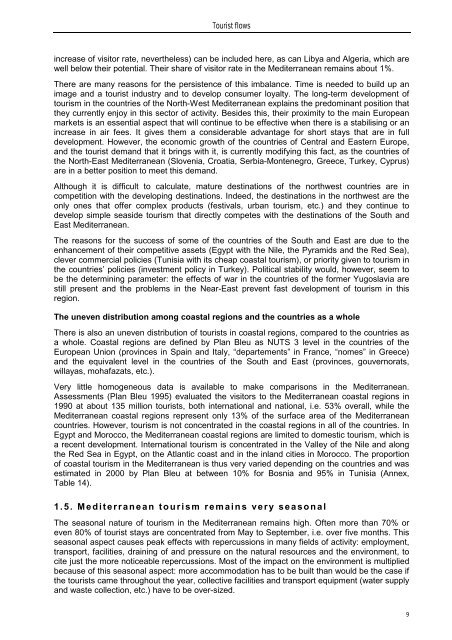dossier sur le tourisme et le développement durable
dossier sur le tourisme et le développement durable
dossier sur le tourisme et le développement durable
Create successful ePaper yourself
Turn your PDF publications into a flip-book with our unique Google optimized e-Paper software.
Tourist flows<br />
increase of visitor rate, neverthe<strong>le</strong>ss) can be included here, as can Libya and Algeria, which are<br />
well below their potential. Their share of visitor rate in the Mediterranean remains about 1%.<br />
There are many reasons for the persistence of this imbalance. Time is needed to build up an<br />
image and a tourist industry and to develop consumer loyalty. The long-term development of<br />
tourism in the countries of the North-West Mediterranean explains the predominant position that<br />
they currently enjoy in this sector of activity. Besides this, their proximity to the main European<br />
mark<strong>et</strong>s is an essential aspect that will continue to be effective when there is a stabilising or an<br />
increase in air fees. It gives them a considerab<strong>le</strong> advantage for short stays that are in full<br />
development. However, the economic growth of the countries of Central and Eastern Europe,<br />
and the tourist demand that it brings with it, is currently modifying this fact, as the countries of<br />
the North-East Mediterranean (Slovenia, Croatia, Serbia-Montenegro, Greece, Turkey, Cyprus)<br />
are in a b<strong>et</strong>ter position to me<strong>et</strong> this demand.<br />
Although it is difficult to calculate, mature destinations of the northwest countries are in<br />
comp<strong>et</strong>ition with the developing destinations. Indeed, the destinations in the northwest are the<br />
only ones that offer comp<strong>le</strong>x products (festivals, urban tourism, <strong>et</strong>c.) and they continue to<br />
develop simp<strong>le</strong> seaside tourism that directly comp<strong>et</strong>es with the destinations of the South and<br />
East Mediterranean.<br />
The reasons for the success of some of the countries of the South and East are due to the<br />
enhancement of their comp<strong>et</strong>itive ass<strong>et</strong>s (Egypt with the Ni<strong>le</strong>, the Pyramids and the Red Sea),<br />
c<strong>le</strong>ver commercial policies (Tunisia with its cheap coastal tourism), or priority given to tourism in<br />
the countries’ policies (investment policy in Turkey). Political stability would, however, seem to<br />
be the d<strong>et</strong>ermining param<strong>et</strong>er: the effects of war in the countries of the former Yugoslavia are<br />
still present and the prob<strong>le</strong>ms in the Near-East prevent fast development of tourism in this<br />
region.<br />
The uneven distribution among coastal regions and the countries as a who<strong>le</strong><br />
There is also an uneven distribution of tourists in coastal regions, compared to the countries as<br />
a who<strong>le</strong>. Coastal regions are defined by Plan B<strong>le</strong>u as NUTS 3 <strong>le</strong>vel in the countries of the<br />
European Union (provinces in Spain and Italy, “departements” in France, “nomes” in Greece)<br />
and the equiva<strong>le</strong>nt <strong>le</strong>vel in the countries of the South and East (provinces, gouvernorats,<br />
willayas, mohafazats, <strong>et</strong>c.).<br />
Very litt<strong>le</strong> homogeneous data is availab<strong>le</strong> to make comparisons in the Mediterranean.<br />
Assessments (Plan B<strong>le</strong>u 1995) evaluated the visitors to the Mediterranean coastal regions in<br />
1990 at about 135 million tourists, both international and national, i.e. 53% overall, whi<strong>le</strong> the<br />
Mediterranean coastal regions represent only 13% of the <strong>sur</strong>face area of the Mediterranean<br />
countries. However, tourism is not concentrated in the coastal regions in all of the countries. In<br />
Egypt and Morocco, the Mediterranean coastal regions are limited to domestic tourism, which is<br />
a recent development. International tourism is concentrated in the Val<strong>le</strong>y of the Ni<strong>le</strong> and along<br />
the Red Sea in Egypt, on the Atlantic coast and in the inland cities in Morocco. The proportion<br />
of coastal tourism in the Mediterranean is thus very varied depending on the countries and was<br />
estimated in 2000 by Plan B<strong>le</strong>u at b<strong>et</strong>ween 10% for Bosnia and 95% in Tunisia (Annex,<br />
Tab<strong>le</strong> 14).<br />
1.5. Mediterranean tourism remains very seasonal<br />
The seasonal nature of tourism in the Mediterranean remains high. Often more than 70% or<br />
even 80% of tourist stays are concentrated from May to September, i.e. over five months. This<br />
seasonal aspect causes peak effects with repercussions in many fields of activity: employment,<br />
transport, facilities, draining of and pres<strong>sur</strong>e on the natural resources and the environment, to<br />
cite just the more noticeab<strong>le</strong> repercussions. Most of the impact on the environment is multiplied<br />
because of this seasonal aspect: more accommodation has to be built than would be the case if<br />
the tourists came throughout the year, col<strong>le</strong>ctive facilities and transport equipment (water supply<br />
and waste col<strong>le</strong>ction, <strong>et</strong>c.) have to be over-sized.<br />
9
















